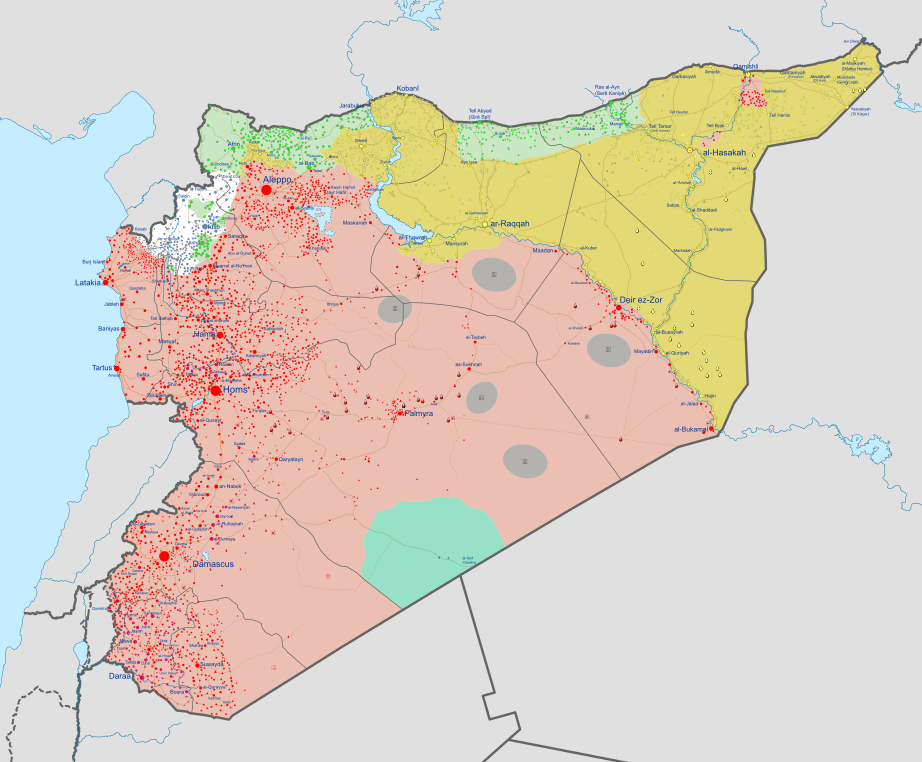

Red: Syrian Government, Yellow: Federation of North Syria(SDF), Grey: Islamic State of Iraq and the Levant, White: Jabhat Fateh al-Sham, Green:Syrian Opposition
| |||||||||||
| Main belligerents | |||||||||||
|---|---|---|---|---|---|---|---|---|---|---|---|
(NPF)
Allied groups
|
(SRCC)
Allied groups
|
(SDF)
Allied groups:
| |||||||||
| Commanders and leaders | |||||||||||
|
|
|
(President of the US) | ||||||||
| Strength | |||||||||||
Syrian Armed Forces: 178,000[34]
National Defense Force: 80,000[36]
Other allied groups: 15,500+[44][38][45] |
FSA: 40,000–50,000[46]
Islamic Front: 40,000–70,000[47]
Other groups: 12,500[52]
Allied groups: 8,500+ | 31,500[55]–100,000[56] |
Syrian Arab Coalition: 4,000 (claimed)
Syriac Military Council: 2,000[59]
Army of Revolutionaries: 3,000[60] | ||||||||
| Casualties and losses | |||||||||||
56,609–91,609 soldiers killed[61][62] 39,221–53,221 militiamen killed[61][62] 6,000 soldiers and militiamen and 2,000 supporters captured[61] 1,247–1,400 killed[61][63] 20 soldiers killed (August 2016)[64] and 9–15 contractors[65][42][66] killed 4,585 killed[61] ( | 95,663–121,663 fighters killed[d][61][62] 979 protesters killed[68] | 8,850+ killed(per SOHR)[69] 16,089+ killed(per SAA and YPG)[70][71][72][73] |
2 killed[76][77] | ||||||||
81,436[61]–94,884[78] (3,160 foreign; mostly Palestinian) civilian deaths documented by opposition
86 other foreign soldiers killed (
Over 7,600,000 internally displaced (July 2015 UNHCR estimate)
Over 4,800,000 refugees (August 2016 estimate NRC Handelsblad)[80]; over4,000,000 (July 2015 UNHCR estimate)[81][82][83]
a Fatah Halab (English: Aleppo Conquest) also includes groups from the FSA.
b Turkey is part of the CJTF–OIR against ISIL, but opposes Rojava and is in a border conflict with it. Turkey has also clashed with the Syrian government and Russia.[84][85]
c Some of the rebels that have been armed by the United States have given vehicles and ammunition to the al-Nusra Front.[86]
d Number includes Kurdish and ISIL fighters, whose deaths are also listed in their separate columns.[87][61][62] | |||||||||||
Lo Stato Islamico ha perso tutto il suo territorio lungo il confine tra Siria e Turchia. Lo scrive l’agenzia turca Anadolu.
Secondo l’agenzia, le truppe turche e i miliziani dell'opposizione siriana loro alleata hanno messo in fuga le truppe dell’Isis dalla zona, compresa tra le città siriane di Azaz e Jarablus, strategicamente importante perché qui transitavano rifornimenti, combattenti stranieri, armi e munizioni. Di fatto il “califfato” è ora isolato dal mondo.
La manovra ha avuto però anche una valenza anti-curda, al fine di evitare l'unificazione delle zone curde al sud della Turchia.
Ha inoltre fortificato le opposizioni ad Assad, nel momento cruciale della battaglia per il controllo di Aleppo.
Il vero vincitore appare il sempre più potente e spregiudicato "sultano" turco Erdogan, che ha ottenuto tutti i suoi obiettivi, mettendo in imbarazzo sia gli Stati Uniti, alleati dei curdi, sia la Russia, alleata del presidente siriano Assad.
Sia Obama che Putin hanno dovuto fare buon viso a cattivo gioco, per mantenere aperto il dialogo con una Turchia che, sfruttando la sua collocazione strategica e la forza del suo esercito, sta portando avanti la classica "politica dei due forni".